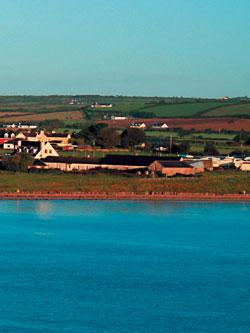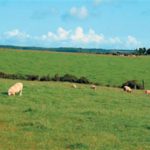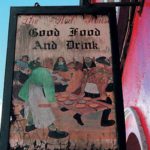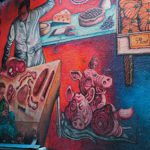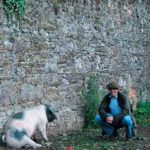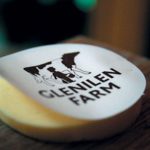Ireland has a lot to offer foodies, from top produce and a newfound culinary confidence in traditional Irish cooking, to fine restaurants and hearty pub fare
NIKKI WERNER
A ham-hock soup is placed in front of me by what looks like the lead singer of an Indie rock band. He’s wearing a waistcoat (no shirt) anda porcine rubber mask. I’m the only patron in Cork eatery An Crúibín – Gaelic for Cork’s specialty dish of pig’s feet – and I’m starting to feel slightly uncomfortable. But Frank O’ Connell makes it his business to make people uncomfortable.
“We try to be purveyors of the truth,” he says. “Sometimes we write on the menu ‘Eat your vegetables’; we want people to know they cost a lot of money and we’ve gone to a lot of trouble to find them!” Frank is one of a number of chefs and food artisans I meet on my road trip from Dublin to Cork who are reviving national pride in Irish cuisine.
Another is Margaret Jeffares. From her ‘little shed’ in Wexford – where her husband grows blackcurrants for Ribena – she founded Good Food Ireland. The organisation pinpoints authentic Irish food experiences and produces a guide (now embedded with QR codes) distributed through Hertz rental cars. Not too far away in Shanagarry, I listen to Darina Allen, the original champion of Irish food culture, as she implores her students, “In Ireland it’s often easier to get a Thai green curry than it is to get an Irish stew… When you go out there, serve gorgeous Irish food: spotted dog, barm brack, porter cake. Serve Irish food proudly!”
Perhaps one positive of the financial crisis is that this message is being heard. It makes good economic sense to buy locally and the nation is in the mood to take comfort in familiar recipes. As beloved Irish food personality Clodagh McKenna explains, “The best thing the recession did for us was to respect quality of life; people started cooking at home again.” Her recently released Gourmand Award-winning cookbook bears the apt title Homemade.
It’s not just foodies who are listening. Gradually An Crúibín fills with 30-something hipsters. Next to me are Ronan and American musician Max, who is studying Gaelic in order to express himself authentically when playing Irish ‘trad’ music.
They order pints of Beamish – the only stout any self-respecting Cork man will touch – and debate Christy Moore of ’70s Irish folk band Planxt (recommended by Patrick of the Cliff House Hotel for when I’d graduated from the diddly-dee-dums and toora-loora-laddies of my Clancy Brothers CD).
Ronan describes bringing his father to An Crúibín. “What’s a tapas?” asked Dad, suspicious of the new-wave approach. He found the answer in a perfect (and undeniably Irish) slice of black pudding on pea purée: “Aah, It’s like a snack!” Frank and his business partner (and friend) Paul Lewis have since gone to weather the economic storm in Barcelona, creating a pop-up restaurant at Santa Maria on the nights chef Paco Guzman closes. But these selfprofessed‘angry young men of Irish food’ haven’t given up the fight.
Before we part ways, they show me the hidden market-scene mural. It’s opposite the Mutton Chop Inn and just below Farmgate Café, where I’m heading for Kay Hart’s deliciously tender corned beef with creamy mustard and parsley sauce. “As a colony, we exported meat for the Napoleonic Wars; it was salted because there was no deep freeze,” explains Kay while serving it.
As custodian of a 280-year-old recipe, Kay takes her role seriously. “It must be served with green cabbage cooked in the same water used to cook the beef,” she continues as I cut into a fluffy Golden Wonder potato – next season will see the variety, British Queen. With precise instructions, Kay turns the tired cabbage-and-potatoes joke of the Irish kitchen into something worth protecting.
Chef Rory O’Connell, who once joined Annette Kesler for a series of cooking demos around South Africa, speaks highly of the carrageen pudding heritage recipe – a lightly set dessert of cream, egg whites and brown sugar with nuances of sweet hay from the mossy carrageen seaweed that grows along the Irish coast. “It makes an impression,” says Rory. “When highprofile international chefs taste it, they sit bolt upright.”
The startlingly fresh plaice Rory so gracefully fillets for teaching purposes is cause to take stock of the region’s bounty. Driving through Wicklow (‘The Garden of Ireland’), then Waterford the (‘Sunny South East’), past grazing sheep and roadside stalls selling crisp apples and lipstick-red strawberries, the country feels like one big farm. Cooking simply (and eating well) using homegrown ingredients comes naturally to the Irish. It’s an honest cooking style best experienced at a country house.
At Ballinkeele House, Margaret Maher – who, with the help of her husband John, was responsible for the hands-on restoration – produces cheese soufflés from her Aga, served on butter lettuce leaves and tomatoes from her walled kitchen garden. After dinner, Margaret tells of the time a rogue bomb dropped in the driveway when the Germans lost their way during World War II and how John came to own the house after his uncle fell in love with (and moved to)South Africa.
At Ballyvolane Country House, Justin Green lives the trend. “In these dark times, people feel like eating more austere food; all that bling food has gone out of fashion.” Looking the part in a woollen poor-boy cap, he introduces me to Lady Gaga, his organically reared pig, and confirms that our roast pork dinner (with cider gravy) is thanks to her relative, Princess Lettuce. He and his wife Jenny also forage and make sloe gin. “I’ll mix you a hedgerow martini tonight,” he says before stoking the drawing-room fire and leaving me to a tray of tea and lemon drizzle cake.
Later Justin, who has done a costume change to velvet blazer, concludes the evening meal by passing around slices of autumn raspberry tart draped in thick cream. By settling in at a country house, the days are filled with possibilities for food adventures, such as booking in at a cooking school in the area or exploring a nearby village, Good Food Ireland map in hand. On contemplating the options, I decide to follow Frank’s advice: “Why don’t you just follow your nose? It brought you here, didn’t it?”
SOURCES
NIKKI WERNER

